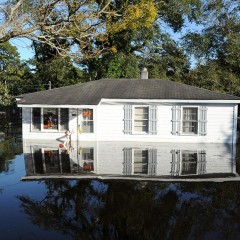In 1993, rains swelled the banks of the Mississippi River to historic and devastating proportions. In the aftermath, the people of one riverside town, Valmeyer, Illinois, decided—collectively—it was time to move. The relocation of about 1,000 residents and almost 350 structures at a cost of around $400 million is celebrated as a powerful example of “managed retreat.”
In a managed retreat, ideally, community members are able to move to safety and stay in close proximity to one another, preserving neighborly ties, social routines, schools, churches, businesses and identities.
Harris County has emerged as a national leader in federally funded buyouts in terms of overall number, accounting for at least 2,500 property acquisitions, the most of any county in the U.S.—and that’s not counting another 1,000 or so done by the Harris County Flood Control District with local funds. The county's buyout program after Hurricane Harvey had another 4,000 homeowners volunteer.
But a true “managed retreat” is harder to come by here, at least for less affluent urban communities, according to a new study by Rice University sociologist Jim Elliott and fellow researchers Kevin Loughran of Temple University and Phylicia Lee Brown, a graduate fellow at Rice. The study is the first of its kind to look at the resettlement outcomes of the buyout program by analyzing where about 1,500 participants in Houston ended up.
“Resettlement like the one that occurred in Valmeyer may be the ideal, but too often it’s also the exception. More often, a local flood authority receives federal funding for resettlement, approaches individual homeowners, and leaves them to decide on their own if and where they will move,’” said Elliott, a fellow at the Kinder Institute. “It’s as if the notion of community disappears when the policy enters urban spaces.”
Left to the whims of market forces and other baked-in inequalities, people who take buyouts do their best to move into better circumstances. But what Elliott and his team found was that property owners from whiter and more affluent flood-prone neighborhoods were more likely to relocate closer to their original home and near others moving through the same program—more like Valmeyer—while homeowners from less affluent and more Black and Hispanic neighborhoods were more likely to disperse in search of affordable living situations.
This was not a small effect. For example, those with home values around $80,000 ended up moving three times farther than those with homes valued at $280,000, or about nine miles away. And not only did these less affluent homeowners move farther from their flood-prone home, they also moved far apart from other buyout participants from their area.
These findings make a lot of sense, given those of the Kinder Institute’s 2021 State of Housing report, which showed that lower-income home-seekers are driving farther from the city to find something they can afford: “The places where poorer and working-class residents can buy and rent are increasingly in the outer reaches of the county, farther from services, jobs and other opportunities critical to upward mobility,” the report notes.
While it’s true these less affluent households are out of harm’s way, they also have to start over in terms of building neighborhood ties and social capital. Their children have to attend different schools, and working parents may be located farther from their jobs. All of this potentially represents a huge step backward in community resiliency, not to mention housing equity, Elliott said. On the opposite side of the spectrum, affluent neighborhoods experiencing buyouts appear to be able to shore up their resources and become even stronger, Elliott’s study suggests—a finding consistent with related research on long-term inequalities linked to disaster recovery.
A collective approach, though, can be also challenging because many less affluent communities understandably distrust government interventions—such as when Kashmere Gardens residents organized to protect themselves from the relocation of 800 households for Project Hunting, bringing the actual number to about 40 after a robust community planning process.
The dispersion of families from less privileged communities has a compounded effect on housing equity and disaster recovery, as previous studies have shown that federal buyouts disproportionately benefit affluent white homeowners, despite the fact that lower-income homeowners are more likely to participate.
Buyout programs are fraught with other perils, too, timing being a big one: In the immediate aftermath of a storm, homeowners are likely to receive offers from investors more quickly than a buyout offer from the government.
The Federal Emergency Management Agency’s Hazard Mitigation Grant Program facilitates most buyouts, but typically only after a federal disaster declaration, which activates funding for recovery programs, including buyouts, home elevations and other mitigation efforts. The federal funds are eventually funneled through state agencies to local flood control authorities, who initiate the applications for buyouts in their jurisdictions. If properties meet a favorable cost-benefit calculation, funds are approved and a “fair” pre-flood market offer is made on the home. By then, months or years may have passed.
Measures that could remedy inequities and speed up the process include local bonds to make buyout funds immediately available in advance of a disaster; making offers on homes that allow families to relocate to homes priced at, say, the median equivalent home in the county; offer incentives for sections of neighborhoods to participate together; and create options that allow residents to relocate nearby but into safer, more resilient housing. Several of these strategies, in fact, appeared in a 2020 report prepared by Harvard University graduate students for Houston’s recovery and resiliency offices.
“Any environmental program that intervenes into the urban housing market, and relies solely on individuals to make choices is going to be ensnared in existing racial housing inequities long in the making,” Elliott said. “And you can't just ignore your way out of that. Color-blind policy and application is going to result in different outcomes for different people.”
Bought-out homes are typically demolished and then returned to green space—which in and of itself can have different outcomes. In an affluent neighborhood, a listing for an adjacent home might tout, “No backyard neighbor!” or “New neighborhood park!” Elsewhere, it might become an illegal dumping ground, because no resources were provided to turn it into a value-added asset.
This is just another example of how the “managed” aspect of “managed retreat” needs to include thorough post-relocation consideration, Elliott said.
“This is a program that was intended to buy out farmers when they were literally and financially underwater. And now it’s moving into cities,” Elliott said. “It’s time to rethink the whole approach in a more proactive way for urban areas that have these deep racial inequalities, and rethink it in a way that acknowledges the social as well as the economic value of housing.”


